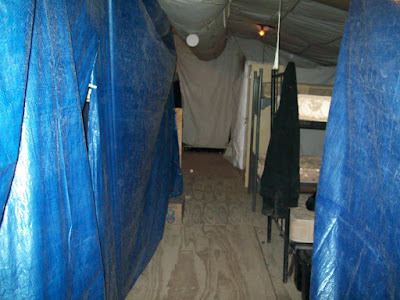Sunrise at Bagram.
Small village outside the wire at Bagram. Only about half of the
windows in the buildings have glass in them.
The above photo reads:
In the summer of 2003, this crossing only existed as a jump across the ditch with a steep climb up the road. One sunny afternoon wile CJCMOTF LTC Tom Berg and CSM Kevin Kamps were executing this crossing, they noticed a slightly exposed metal ring in one of the footholds created by many soldiers wanting to cross the street en route to the original Viper tent village. Having previously attended a landmine class (and having paid attention), they stopped movement on the gravel walkway and alerted Base Ops. The entire intersection was cordoned off, stopping Disney traffic for over 30 minutes, and EOD was brought in to unearth the potential mine. The mission was successful and EOD dug up........an unopened can of Russian tuna fish. Not long after, the bridge was constructed and named "Tuna Bridge" in honor of this event.
EOD is Explosive Ordinance Disposal
Disney one of the main roads at Bagram, and is heavily traveled.
Ok, can anyone see the problem with this picture? Remember,
this truck is full of diesel fuel.
Lonely road on the far southwest side of KAF.
Controlled detonation (I hope) of a land mine taken from above road.
Canadian drone launcher and recovery system. The drone gets
sling-shotted from the device on the right. When it is time for
recovery, the drone flies into the wire hanging from the boom on
the left, gets caught in midair and goes into a controlled spiral,
landing at the bottom.
Sunrise over KAF.
The last four pictures were all taken within a few feet of each other,
on the southwest corner of KAF.





















































